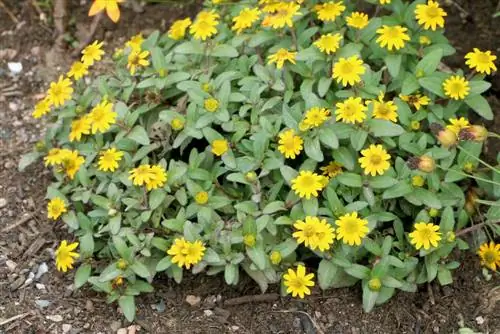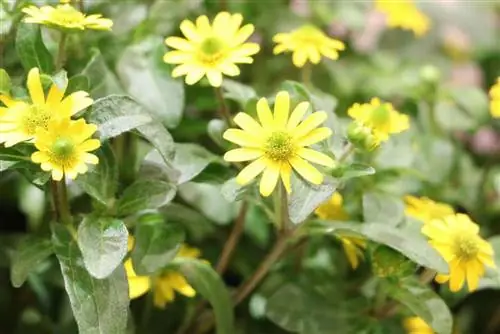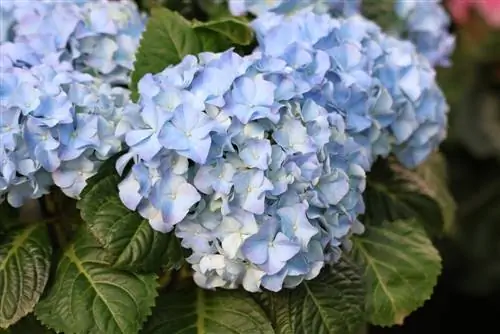- Author admin [email protected].
- Public 2023-12-17 03:39.
- Last modified 2025-06-01 06:48.
Hussar heads belong to the daisy family (Asteraceae). The graceful hussar's head is characterized by herbaceous green foliage, thick stems and small ovate, pointed leaves. The many medium-sized flowers are yellow. They have a cushion-shaped, sometimes brown flower center and 12 petals arranged in a radial pattern. The plant grows very branched, creating a dense yellow carpet of flowers. The summer flower reaches a height of approx. 25 cm to 35 cm and prefers a sunny to semi-shady location.
Hussar heads are annuals. There are many different varieties of the decorative summer plant. It is suitable as an underplant and ground cover and is a grateful hanging basket, balcony and container plant for terraces, balconies and house entrances. - Already knew? The species-poor “Procumbens” means “procumbent” and refers to the growth habit of the hussar’s head.
Origin
The hussar head (Sanvitalis) has been known in Europe since the end of the 17th century. Researchers and traders brought the magical flower from Mexico and Guatemala to Europe. Due to its appearance, the hussar's head is also popularly known as a dwarf sunflower. In nature, the hussar's head grows at altitudes of up to 1,300 meters. It is considered a weed because it spreads widely in farmers' fields. The botanical name “Sanvitalia” was chosen after the Italian botanist Sanvitalia (1704 to 1767).
Location
Hussar heads need a warm, sunny to shady location. The more sun the plant receives, the better it develops and the more flowers it produces. As a balcony plant and from hanging baskets, the Hussar's head grows very decoratively, slightly overhanging. It is impervious to rain and wind.
Substrate & Soil
The substrate should be loose and permeable. Sanvitalis procumbens is sensitive to waterlogging. Planters should be provided with drainage and have a drain. Heavy soils and potting soil for balcony plants can be made a little more permeable with sand and gravel.
Watering and fertilizing

The soil must always dry out before the hussar head is watered. However, the earth should never dry out completely. During the main growing season, an application of complete fertilizer every two weeks is recommended.
Planting and Propagating
The hussar head is the ideal plant for the edge of balcony boxes and hanging baskets. Three hussar heads per hanging basket are enough for a dense bloom. Young plants from specialist retailers are available from spring. They are put out into the open after the Ice Saints. A planting distance of between 10 cm and 15 cm is sufficient. Sowing seeds on the windowsill is done in February.
Tip:
The seeds can be obtained from dead flowers in the autumn of the previous year or they can be bought packaged in stores.
The fine seeds are mixed with sand for better distribution and then lightly dusted with soil. At a temperature of 18 °C, the first seedlings appear after around two weeks. A mini greenhouse is not absolutely necessary because of the low sowing temperatures. If the plants are sufficiently large, they are separated with a pricking stick. The first flowers of the hussar's head appear on fully trained plants in June.
Cutting
A hussar's head should be cut when the plant grows poorly and no longer produces inflorescences.
Tip:
You can cut the plant back by up to two thirds. If Sanvitalis procumbens is he althy, it will sprout again immediately and form a dense carpet of flowers.
You can also cut off shoots and faded inflorescences that have become too long. Both care measures promote new growth.
Please note: With new varieties, dead plant parts no longer need to be plucked off.
Pests
The hussar head is considered very resilient. It is not affected by diseases or pests. Even snails avoid the frugal plant. Root rot is promoted by a stand that is too wet.
Wintering
Hussar heads are annual plants. It is not possible to overwinter the plants. The hussar's head sows itself in the garden bed. While the mother plant dies in autumn, the seeds overwinter protected in spaces between paving stones and terrace tiles or under stones and sprout in spring when it gets warm.
Various varieties with names
The genus Sanvitalia is divided into seven species and numerous new varieties:
- medium yellow flowers - Cuzo Ideal
- dark yellow flowers - Emily
- yellow flowers - Yellow Bird, Talya Sunny
- golden yellow flowers with brown-black center - Gold Braid
- yellow to orange flowers - Irish Eys
- compact very early blooming yellow flowers - gold carpet
- medium yellow flowers - Million Suns,
- orange flowers - Mandarin Orange
- semi-double flowers - Plens
- dark yellow flowers - Sanvitos Sweet Penny
- medium yellow flowers - Solaris, Sunvy Trailing
- warm yellow flowers - Sunbinii
- strong yellow flowers - Sunvy Super Gold
By the way: The hussar head is almost indistinguishable from Aztec gold.
Suitable combination partners
Purple petunias, blue verbena and bluebells go well with the yellow-colored hussar head. A palette of yellow and orange forms hussar heads with marigolds, slipper flowers, yellow daisies and nasturtiums. The ground cover complements tall stems and shrubs. A dark background looks particularly decorative. Other combination partners are ivy, thyme or phlox.
Frequently asked questions
What are the differences to the real sunflower?
The hussar's head grows densely branched, does not grow that tall and only needs a small amount of nutrients. In addition, the hussar's head requires less water than the sunflower.
How did the hussar head get its name?
The plant resembles a uniform button. Hussars were cavalry and rode horses. Sanvitalia should not be confused with Acella oleracena, which is also known as hussar's head. Although the paracress is yellow, it does not have distinctive petals. Hussar's Head Sanvitalia is poisonous.
Is the hussar's head a solitary plant?
No, the summer flower doesn't push itself into the foreground.
Are there any special considerations when propagating?
One gram of seeds contains around 1500 seeds.
What you should know about hussar heads in brief
Sowing
- Hussar heads can be grown in pots on the windowsill from March or sown directly outdoors from the end of April.
- Your seeds are placed in twos or threes in pots with potting soil and only lightly covered with soil.
- In the following period, the seeds must always be kept moist. It requires a temperature of around 18°C to germinate.
- After 10 to 14 days, the germinating plants can be kept a little cooler, but they definitely need a bright location.
- When the young plants have reached a sizeable size, they should be pricked out.
- However, they are only planted out in the garden from mid-May so that the young plants are not damaged by late night frosts.
Plants
- Hussar heads grow best in a location in the garden where the sun shines on them most of the day.
- If necessary, they can also be planted in a partially shaded area, but then they may not bloom quite as diligently.
- The soil should be loosened well before planting so that no waterlogging can occur, which would harm the plants.
- If the soil is very dense, it is helpful to mix some sand into the ground so that the rainwater can drain away easily.
- Conventional potting soil is completely sufficient for planting in pots or balcony boxes.
- After two to three months, these plants should also receive a little additional fertilizer.
Cut
If there are hardly any flowers forming over the course of the summer, they should be cut back a little to encourage them to bloom again. However, Hussar buttons are annual plants and therefore have to be sown or bought again every spring.


